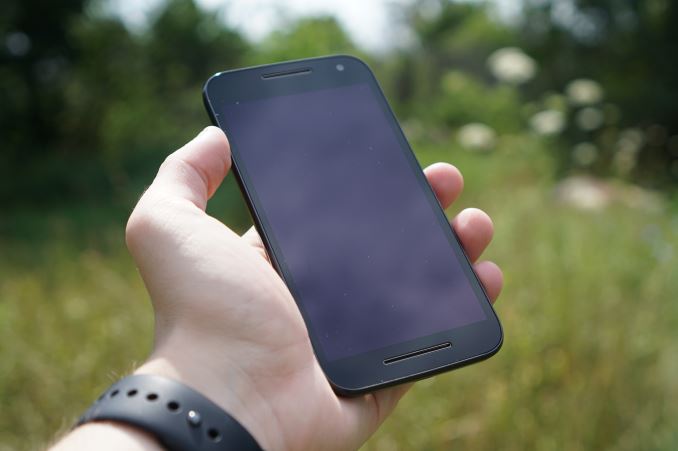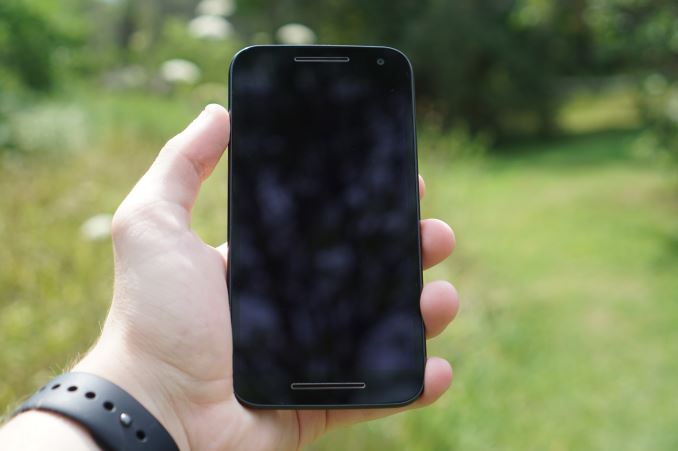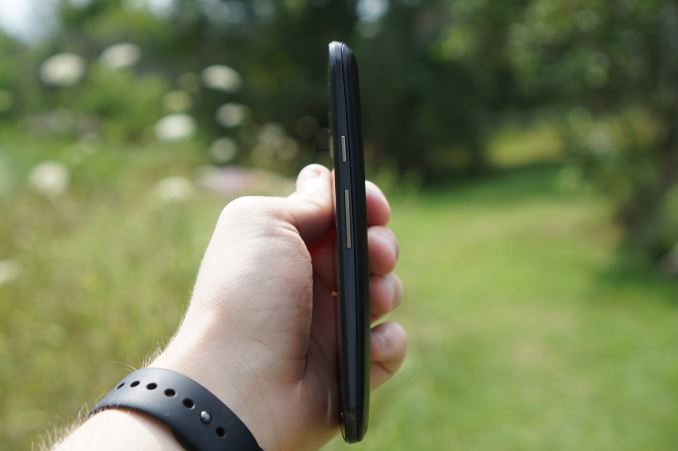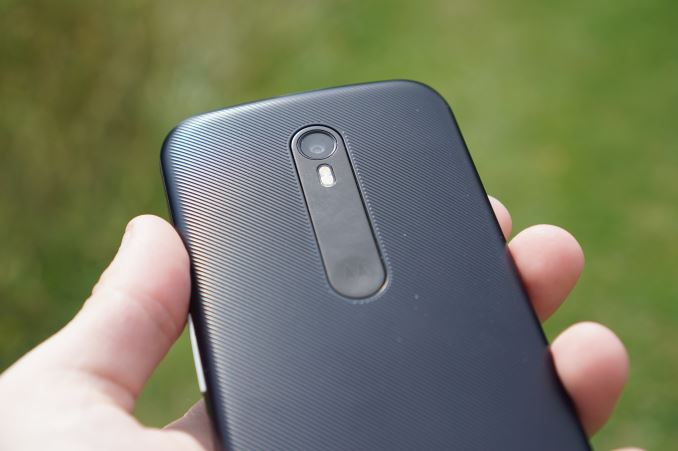The Moto G (2015) Review
by Brandon Chester on August 19, 2015 8:00 AM EST- Posted in
- Smartphones
- Mobile

Motorola's original Moto G was one of the first Android devices to offer what one could honestly call a good user experience at a price of around $200. It had a 4.5" 720p display, Qualcomm's Snapdragon 400 SoC, a 5MP rear camera, 1GB of RAM, and 8GB of memory. Since that time, Motorola has adopted a structure where their Moto E fills in the sub $150 range, the Moto G hovers around $200, and the Moto X acts as a several hundred dollar flagship device, although the dual Moto X launch for 2015 changes this slightly. In early 2014 we saw Motorola refresh the Moto G with support for LTE, and later in the year they did a more major refresh which bumped the display size to 5", the camera resolution to 8MP, and added the microSD slot from the LTE model of the original version.
While Motorola's 2014 refresh of the Moto G was technically a major update as far as their yearly cadence was concerned, many aspects of the phone remained the same. There was no change to the SoC or the amount of RAM, no change to the display resolution or connectivity, and no change to battery capacity. The early 2015 launch of the Moto E made things even stranger, as it shipped with some specifications that actually outclassed the Moto G, such as Qualcomm's Snapdragon 410 SoC. This put Motorola in a strange situation, which has finally been resolved with the new 2015 model of the Moto G. In my view, this is the first truly major update that the phone has seen since the original version, and you can see what improvements Motorola has made in the chart below.
| Moto G (2014) | Moto G (2015) | |
| SoC | Snapdragon 400 1.2 GHZ A7 | Snapdragon 410 1.4 GHz A53 |
| RAM | 1GB | 1/2GB |
| NAND | 8GB NAND + microSD | 8/16GB NAND + microSD |
| Display | 5” 720p IPS |
5” 720p IPS |
| Network | 2G / 3G / 4G LTE | 2G / 3G / 4G LTE (Category 4 LTE) |
| Dimensions | 141.5 x 70.7 x 11mm, 149g | 142.1 x 72.4 x 6.1-11.6mm, 155g |
| Camera | 8MP Rear Facing (Sony IMX179) f/2.4, 1.4 micron 1/3.2" sensor | 13MP Rear Facing (Sony IMX214) f/2.0, 1.1 micron 1/3.06" sensor |
| 2MP Front Facing | 5MP Front Facing | |
| Battery | 2070 mAh (7.87 Whr) | 2470 mAh (9.39 Whr) |
| OS | Android 4.4 (At Launch) | Android 5.1 (At Launch) |
| Connectivity | 2.4 GHz 802.11b/g/n + BT 4.0, USB2.0, GPS/GNSS |
2.4 GHz 802.11b/g/n + BT 4.0, USB2.0, GPS/GNSS |
| SIM | MicroSIM | MicroSIM |
| Launch Price | $179 (1GB/8GB) | $179 (1GB/8GB) $219 (2GB/16GB) |
As you can see above, this year's iteration of the Moto G brings along some significant improvements. For the first time ever, we're seeing an update to the Moto G's SoC. While both the first and second generation models used Qualcomm's Snapdragon 400 SoC with four 1.2GHz Cortex A7 cores, this year's model adopts a 1.4GHz version of Snapdragon 410 with four Cortex A53 cores. The battery also receives a hefty bump in capacity, although this does come along with an increase in height, width, and thickness, as well as a slight increase in mass. Memory remains the same for the base model at 8GB of NAND and 1GB of RAM, but an extra $40 bumps that to 16GB of NAND and 2GB of RAM.
The rear-facing camera moves from Sony's IMX179 sensor to IMX214 which interestingly enough is the same improvement that was made going from the Nexus 5 to the Nexus 6. The sensor size increases from 1/3.2" to 1/3.06", and the resolution is bumped to 13MP from 8MP. This means that pixel size drops from 1.3 micron to 1.12, and low light scenarios may see a reduction in image quality as a result, but the wider F/2.0 aperture can help to offset this. The front-facing camera also jumps from a 2MP to a 5MP sensor.
Connectivity and the display don't see any improvements with this upgrade. We're still looking at a 5" 1280x720 IPS display, and with WiFi and Bluetooth you get 2.4GHz 802.11n and Bluetooth 4.0 LE.
Design
At this point, Motorola's industrial design is fairly well known and understood. All of their devices, from the Moto E all the way up to the Nexus 6, have essentially the same chassis shape with differing dimensions. The big difference between Motorola's devices is the materials that are used. While Moto Maker allows users to customize their devices to some extent, more expensive devices may have special options like wood back covers, and may have metal frames around the chassis rather than plastic ones. Being a mid-range smartphone, the Moto G is made primarily of plastic.
When it comes to the front face and sides the 2015 Moto G continues to share a design with Motorola's other devices. It has speakers sitting above and below the display, and a front facing camera sitting to the right of the upper speaker. The sides are flat on the edge that meets the display, and curved on the edge that meets the back cover. Both the power button and volume rocker are located on the right side of the phone, and the power button has the same texture to it as the Nexus 6 and Moto E, which makes it easy to tell apart from the volume rocker. Something that does concern me a bit about the sides of the device is the large gap between the back cover and the rest of the device. There are points where the gap is wide enough that you can feel it decreasing in size when you grip the phone in that area, which concerned me both because it negatively impacts the feel of the device, and because the Moto G is supposed to be waterproof.
The back of the 2015 Moto G is where things depart slightly from how Motorola devices usually look. On older Motorola devices, the rear-facing camera sat above a small indent which had the Motorola logo inside it. The camera flash either sat between the logo and the camera, or was integrated into the ring around the camera itself. All of these features were separate and sat flush with the back cover. The new Moto G and Motorola's recently launched Moto X devices now have a strip which connects the camera, flash, and Motorola logo and puts them slightly below the level of the back cover.
Since the Moto G can be customized with Moto Maker, there will potentially be differences between a consumer's device and the review unit I have. In my case, the Moto G's back cover is made of black plastic, with a series of raised diagonal lines which gives it a different feeling from a device with a smooth back like the Moto E. I personally prefer the in hand feel of this back cover to the smooth slippery plastic on the Moto E, and I think the black color goes very well with it.
As I mentioned earlier, the Moto G is waterproof. Its IPX7 rating specifies that it can be submerged up to 1 meter deep for up to thirty minutes. While I didn't push the device to that limit just due to worries about possibly damaging a review unit, I did put it under thirty centimeters of water for around twenty minutes and it did not sustain any damage. All back covers for the third generation Moto G have plastic sections that fit into and protect the open ports on the back of the phone from any water getting in. While there was absolutely no damage, you can see above that water was able to get between the back of the chassis and the back cover even though I made sure to secure the back cover tightly and properly. I don't believe this to be any cause for concern, but I felt it was worth sharing. With a removable back cover this issue can't really be avoided, and the inserts that block important ports have kept water out of the areas that need to be protected.
In the end I think the 2015 Moto G has a good feel in the hand, and I think the build quality is more than acceptable for a phone that starts at $179. I definitely prefer the textured back cover to the smooth and slippery ones on some other Motorola phones, and if you're given that option I would definitely opt for it. My only complaint is that the back cover doesn't attach as tightly to the phone as I would like, and you can notice the gap when you touch it at the edges. The gap also seems to be big enough to let water through, but the protective covers on the back cover ensure that the phone won't get damaged.















90 Comments
View All Comments
boozed - Wednesday, August 19, 2015 - link
I'm sorry that my joke wasn't more obviously a joke!You asked which non-existent phone you should buy. I don't even know whether Apple intends to produce an "iPhone 7 mini". Nobody knows how these hypothetical phones will compare, and you also provided no information regarding your requirements.
Samus - Thursday, August 20, 2015 - link
The simplicity of the interface and the support behind it are the most attractive features of the iPhone. This coming from someone who works in IT managing enterprise-scale infrastructure. A lot of my friends in IT that used to laugh at me over my iPhone have either slowly migrated or are too stubborn to give it a shot.Given the opportunity, I think almost any Android or WinMo diehard would switch to an iPhone if they just tried it for awhile. The pro's simply outweigh the con's and the only reason Android sells is because of general acceptance, low price or simply put, Apple hate.
And I get it, Apple is an easy company to hate, but don't hate a superior product. Android is catching up, but it's still behind in key areas. The few things it does better than iOS really don't matter when you consider the gaping holes it has.
Every old iPhone I've ever had, I gave away to a friend who had been using an Android device, usually a nice one like a Nexus or a Galaxy S III. And every single one of them still rocks that old iPhone.
amdwilliam1985 - Thursday, August 20, 2015 - link
Yeah, I know what you mean.Granted, phone to phone comparison, there probably isn't a single phone that can beat iPhone in all/most categories. Overall, iPhone is a good balanced phone that I would recommend to everyone(especially non-tech people, both of my parents uses iPhone).
As for myself, I can't stand iPhone for more than 5 minutes. I've played with every generation of iPhone, and I am always impressed by it [for like 5 minutes]. I'm like, damn, this is such nice phone, and then, damn this is such BORING phone.
So in conclusion, if you just want a phone that works, iPhone is on the top the recommend list. So, I wouldn't mind using iPhone as my daily driver if it's like for free. If i have to pay $400+ for my smart phone, then it better keep me interested for more than 5 minutes.
Kind of like buying a car, I will just recommend and/or go for Toyata/Lexus, because I just want a car that works and I'm not a car junky.
grant3 - Thursday, August 20, 2015 - link
" the only reason Android sells is because of general acceptance, low price or simply put, Apple hate."Low price is a pretty legitimate reason to prefer a device...
This whole "the only reason people don't use iphone/macs/etc. is because they hate apple" is as a worthless, overdone meme, and should be trashcanned along with "the only reasons people buy iphone/macs/etc. is because they're sheeple who only care about image".
FYI, the phone which receives the highest ratings for user satisfaction is the Samsung Galaxy Note 4 (beating out iphones). Maybe, just maybe, we can give credit to people for generally picking devices which suits them.
Brianbeastsu - Sunday, August 23, 2015 - link
I am also in a similar field and as far as contol is concerned the Iphone is definatly superior. THat being said I love the way the Iphones are built so after being a longtime android user made the switch to the Iphone 6 plus. For what I use it for the Iphone jsut couldnt hold a candle to android(Stock android, all nexus devices I dont know muich about the others out there like samsung or LG). I had Chrome force close on me more in the first 15 days with it then 5 years with android.ALl that being said, I know I am a unique user when I recently switched carriers and did a data use audit I was close to 40 gb a month(not a brag cuz its not cool haha just fact). When my mom, friends who dont like to tweak and tinker with technology ask me what tog et I alwasy explain that if you want something to make calls and is easy to use with no learning curve at all go with the iphone.
Lastly you mention cost but forgot about why apples stuff sells in general...........Apple is OUT of their minds with their prices right now and sadly everyone keeps buying their stuff without even researching the market because its in large partr a fashion accessory....which is why beats headphones fits in their ecosystem so well.....marketing genius when you could buy Audio Technica 50x's for 11/4 of the price and 10x the quality.
ajfink - Wednesday, August 19, 2015 - link
Completely different price ranges. The Moto X Play and new Nexus 5 will have much higher performance, better screens, better cameras, a few more bells and whistles, but are obviously more expensive.cknobman - Wednesday, August 19, 2015 - link
I'm getting the Moto X Pure. Was going to try and get a OnePlus 2 but the stupid invite system and wait has pissed me off.Moto X pure is going to be an awesome device for $400.
amdwilliam1985 - Thursday, August 20, 2015 - link
Moto x starts at $400 for 16GB, right?With no microSD card, 16GB will not work, what's the price for 32GB? $450 or $500?
duynguyenle - Thursday, August 20, 2015 - link
Both the 2015 Moto X Play and Moto X Style has MicroSD card slot for up to 128GB cardsdragonsqrrl - Saturday, August 22, 2015 - link
Based on the current leaked specs for the Nexus 5, I would without a doubt choose it over the Moto X Play. 5.2" 1080p display, ~3000mAh battery, front facing stereo speakers, USB type C... Google gets it.